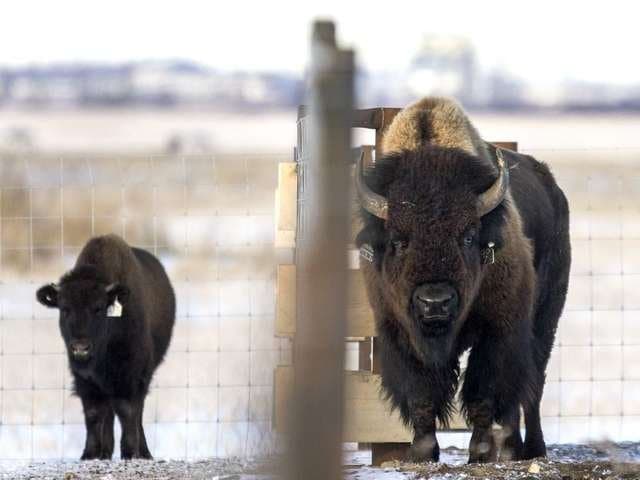A piece of history: Bison reintroduced to Wanuskewin Heritage Park site

The 11-strong herd of plains bison may be small, but the implications they have culturally and for conservation of the species are huge.
The landscape has changed since bison roamed the prairies around Saskatoon.
At Wanuskewin Heritage Park, just north of the city, giant steel bins can be seen jutting into the sky from a distant grain elevator. The sounds of cars from the nearby highway are audible on a quiet day.
But for a moment in December, that all fell away for Darlene Brander.
Brander joined a few dozen people to welcome plains bison back to the site, more than a century after the animals last walked there.
Rows of chairs, set up in front of the park’s new bison paddock, went largely unused as the group huddled close to the fence.
The trailer carrying the animals was driven into the paddock and, as its doors opened, Brander felt a sense of awe swelling in her chest.
A drum circle performed bison songs that carried through the stillness, welcoming the animals home. For a moment the bison didn’t move. Then six dark shapes exploded out of the trailer onto the snow-covered grass and disappeared from sight.
After they’d gone, people were overcome — some cried, while others cheered and hollered.
“The bison are a powerful creature that elicit powerful emotions,” said Brander, the CEO of Wanuskewin Heritage Park who hails from Red Earth Cree Nation. “People can see the bison and it elevates something within people on a spiritual level.”

The first bison to arrive at Wanuskewin Heritage Park head off to explore their new home.
The site of Wanuskewin Heritage Park has been a gathering place for Indigenous people for more than 6,000 years. Historically, many ended up there because they followed the bison, which once numbered in the millions in North America.
That vision became a reality late last year. Six calves from Grasslands National Park in southern Saskatchewan were brought to Wanuskewin in early December and five animals from a ranch in South Dakota — a bull and four pregnant cows — joined them later that month.

A plains bison calf from Grasslands National Park, on the left, is separated from a plains bison bull that travelled to Wanuskewin Heritage Park from South Dakota. The two herds won’t be combined until the Grasslands calves reach two years of age.
The herd was unveiled to the public Friday morning after the bison had been given time to adjust to their new surroundings. Over time, the herd is expected to grow to about 50 animals.
Plains bison were critical to the way of life of Indigenous people on the North American plains, but the species faced extinction by the late 1800s following the arrival of European settlers. Nearly losing them to overhunting post-contact had a devastating effect.
Conservation efforts have since allowed the animals to make a comeback and several plains bison herds now exist across the continent, including conservation herds in a handful of Canada’s national parks.
Tara Janzen, the development manager at Wanuskewin Heritage Park, said the park wants to be part of sharing that history.
“The story that we’re aiming to tell with the world heritage process is some level of restoration of that balance,” Janzen said. “The gathering place that is Wanuskewin helps restore those human connections. The return of the bison is that tangible symbol of that: a reminder of strength and resilience and something that was nearly lost that’s back.”
Cy Standing, an elder from the Wahpeton Dakota Nation, is part of an elder advisory group for Wanuskewin and has long been an advocate for bringing bison back to Wanuskewin.
For the Dakota nation, the animals were family, Standing said. The continuance of the species contributes to the furthering of Dakota culture.
“Our nation, they would call them our relatives because one or the other came first in our creation stories,” Standing said. “The buffalo came with the Dakota for them to support our living, so they provided everything for us.”
The archeological record uncovered over the course of Wanuskewin’s existence has been bison-centric. With a buffalo jump in the park — a cliff formation used by Indigenous people for hunting the animals — it only makes sense to have bison, Standing said.
Park founder Ernie Walker feels the same way. Having bison in the park is the fulfilment of decades of work and centuries of history, he said.
“I talk a lot about the history of the park. How it got going, what happened along the way, the Wanuskewin story. I’m not a religious man, but there have been little miracles along the way,” Walker said. “To me the miraculous part to this is that it didn’t happen anywhere else, it happened here. You actually have plucked up history, moved it over and dropped it in here. How often does that happen?”
That the park was able to secure animals from two different herds is significant. The bison from Grasslands can trace their ancestors back to animals that once lived in Elk Island National Park in Alberta.
The bull comes from a wild herd in Yellowstone National Park that is difficult to access, making the Wanuskewin herd the first in Canada to include animals from two populations that haven’t interacted since they were wild.
Right now, the two groups are separated. The park is expecting the pregnant South Dakota cows to give birth in the spring and all the animals will be allowed to intermingle in 2021.
Brander said she hopes the presence of the animals at Wanuskewin connects people, brings them together and revitalizes their connections to the land and each other.
“It’s the opportunity to share with the world the deep kinship connection Indigenous cultures have with the bison” Brander said.
“They’re a great catalyst to building a better humanity.”
thestarphoenix.com/news/local-news/a-piece-of-history-dropped-into-wanuskewin-heritage-park-bison-reintroduced-to-site-north-of-saskatoon-in-emotional-ceremony